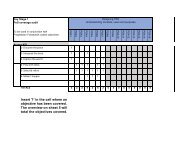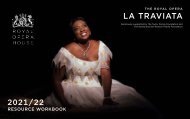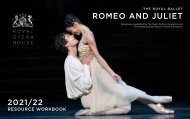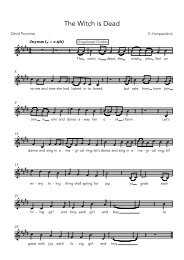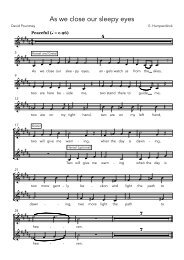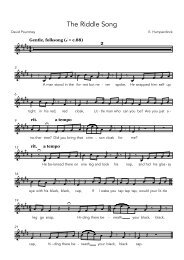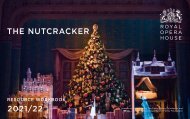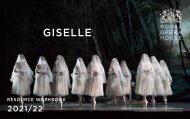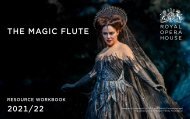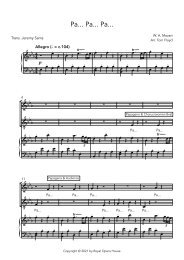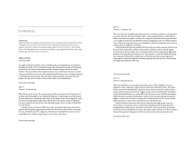Infra E-resource pack 2018
Create successful ePaper yourself
Turn your PDF publications into a flip-book with our unique Google optimized e-Paper software.
APPRECIATION – WHAT DO YOU SEE?<br />
106<br />
GCSE DANCE APPRECIATION<br />
EXAMPLE QUESTIONS AND ANSWERS FOR INFRA (2008)<br />
1 Possible answers:<br />
Highlight, Climax, Contrast<br />
the individual human side<br />
of the city by the dancers<br />
beneath. The pedestrian,<br />
Often changes in lighting<br />
take place with a change<br />
in the sound and signify<br />
surface of the city. The<br />
dancers wear everyday<br />
garments, such as short<br />
1 Name a choreographic device used in <strong>Infra</strong> that helps to communicate the<br />
theme of ‘life beneath the surface of the city’.<br />
2 Explain how the choreographic device you have named in question 1 helps<br />
the audience’s understanding of the theme of ‘life beneath the surface of<br />
the city’.<br />
3 Name the performance environment used for <strong>Infra</strong>.<br />
4 Discuss how the set and the lighting in <strong>Infra</strong> contribute to the mood of the<br />
work.<br />
5 Discuss how the costume designs for <strong>Infra</strong> are used to enhance our<br />
appreciation of the work.<br />
2 Contrast:<br />
In section 5 a male dancer<br />
performs a strong, fluid<br />
and technical solo that<br />
is contrasted with a<br />
male/female duet in the<br />
background. The couple<br />
use a more pedestrian<br />
movement style, such as<br />
talking, kissing and holding<br />
hands. Through observing<br />
their intimate moments, we<br />
feel we are seeing a more<br />
human side to the uncaring<br />
exterior of the city.<br />
In section 7b a female<br />
dancer stands fixed to<br />
the spot, grief-stricken,<br />
in the centre of the stage<br />
as the company move,<br />
emotionless, walking from<br />
stage right to stage left.<br />
This contrast draws the<br />
audience’s focus to the<br />
lone female dancer and<br />
her obvious despair and<br />
reinforces the idea that<br />
people’s true emotions go<br />
on beneath the surface,<br />
unnoticed by the strangers<br />
around them in the city.<br />
The sharp contrast between<br />
the six duets in section 4<br />
and the male solo in section<br />
5 encourages the audience<br />
to view each dancer as an<br />
individual character and not<br />
just a cog in the machine of<br />
the city.<br />
3 Proscenium Arch<br />
uniform movement of the<br />
figures on the LED screen<br />
is in contrast to the varied<br />
and dynamic movement<br />
of the performers, which is<br />
very effective.<br />
The figures in the LED<br />
screen are carrying<br />
briefcases and wearing<br />
office clothing, which<br />
indicates both the social<br />
and geographical contexts<br />
of a bustling city in a<br />
developed country. The<br />
figures are white outlines<br />
against a black background,<br />
connecting them to the<br />
monochrome costumed<br />
figures of the dancers<br />
below.<br />
The stage space the<br />
dancers move in is open<br />
and doesn’t contain any<br />
set or props at floor level.<br />
This gives a sense of the<br />
isolation the characters<br />
feel within the expanse of<br />
the city. During the female<br />
dancer’s grieving solo (in<br />
section 7b), the rest of<br />
the company enter from<br />
the side (stage right).<br />
Their walking echoes the<br />
graphics of the walking<br />
people on the screen above<br />
and reinforces the idea that<br />
the city can be a lonely<br />
place despite being heavily<br />
populated.<br />
The lighting in <strong>Infra</strong><br />
is largely stark and<br />
the start of a new section<br />
of the dance. This helps<br />
the audience to view the<br />
different scenes and the<br />
relationships within them<br />
more clearly. An example<br />
of this is the change from<br />
white light to green, as<br />
the first duet (section 2)<br />
finishes downstage and the<br />
second duet (section 3)<br />
begins upstage.<br />
In section 4, the rectangles<br />
of white light on the floor<br />
of the stage could be<br />
seen to represent many<br />
different architectural<br />
aspects of a city, helping<br />
the audience to understand<br />
the geographical location<br />
of the dance. They create<br />
small spaces for the duets<br />
to take place in, and could<br />
be viewed as windows into<br />
the individual worlds of the<br />
couples, or the small rooms<br />
in their city apartments.<br />
In one section, a male<br />
dancer is lit in a yellow<br />
light wash as he begins his<br />
solo. The change in lighting<br />
colour coincides with a<br />
change in sound, from the<br />
live contemporary music<br />
to the noise of machines.<br />
The yellow lighting,<br />
coupled with the sound<br />
score, suggests a rise in<br />
temperature and could<br />
be seen to represent the<br />
oppressive heat of the city.<br />
and long-sleeved t-shirts<br />
and vests, briefs, trousers<br />
or short skirts, alluding to a<br />
contemporary context. This<br />
context is reinforced when<br />
the company wear ‘street<br />
clothes’ as they walk past<br />
the static, grieving female<br />
dancer in section 7b.<br />
Although the costumes<br />
are similar in style and<br />
use a small colour palette,<br />
each is unique, which<br />
communicates that<br />
each dancer portrays an<br />
individual character. The<br />
costumes for the dancers’<br />
torso areas are tight-fitting,<br />
which sculpts their bodies<br />
and enables the audience<br />
to see the movements of<br />
their spines.<br />
The dancers’ limbs are<br />
exposed, either arms,<br />
legs or both, which<br />
enhances the lines of their<br />
bodies and highlights the<br />
extensions of their limbs<br />
in the choreography. This<br />
is complemented by their<br />
flesh-coloured ballet and<br />
pointe shoes, which give<br />
the impression of no<br />
footwear and elongate the<br />
extensions of the dancers’<br />
legs. The female dancers<br />
wear pointe shoes, enabling<br />
them to draw on classical<br />
movement.<br />
4 Julian Opie’s LED<br />
figures walk across<br />
the top of the<br />
performance space.<br />
This effect supports<br />
the theme of ‘below’ by<br />
representing the day-today<br />
city life continuing<br />
above as we are shown<br />
minimalistic, with most<br />
of the stage lit in a single<br />
colour wash at a time,<br />
gradually becoming darker<br />
at the edges of the stage.<br />
This creates a sense of<br />
depth to the space and<br />
gives the impression of<br />
the vastness of the city.<br />
5 Moritz Junge’s<br />
costume designs are<br />
all in a monochrome<br />
colour palette with<br />
some flesh-coloured<br />
items.<br />
This supports the mood<br />
and atmosphere of the<br />
piece; the dark, emotionless





